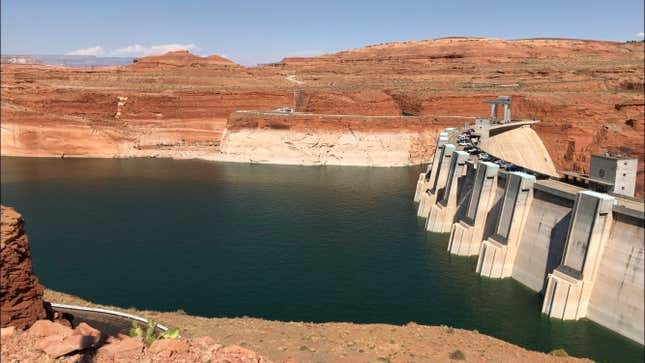
On Tuesday, the federal government announced that it will take unprecedented steps to maintain water levels in Lake Powell and stave off an electricity supply catastrophe for the Southwest.
The Bureau of Reclamation will release an extra 500,000 acre-feet of water into Lake Powell from the upstream Flaming Gorge Reservoir. Another 480,000 acre-feet of water in Lake Powell that would have otherwise been sent downstream to Lake Mead will be held back. In total, the water added to Lake Powell will be enough to fill more than 483,000 Olympic-size swimming pools.
The actions come amid ongoing, record drought (exacerbated by climate change) in the U.S. Southwest. The water levels in both Lake Powell and Lake Mead are the lowest since the reservoirs along the Colorado River were first filled.
On top of providing drinking water for millions of people reliant on the Colorado River Basin system, Lake Powell also provides electricity for about 5.8 million households and businesses across the western U.S. That power comes from Glen Canyon Dam’s hydroelectric production.
But the dam can only produce electricity if the reservoir’s water level is at or above 3,490 feet. Lake Mead, on the other hand, can continue powering its Hoover Dam hydroelectric operation until an elevation of between 925 and 950 feet. As of writing this, Lake Powell’s water level is sitting around 3,523 feet above sea level, and Lake Mead is at about 1,054 feet.
The decision to hold 480,000 acre-feet of water in Lake Powell is a historic one. “We have never taken this step before in the Colorado River Basin. But, the conditions we see today and the potential risk we see on the horizon demand that we take prompt action,” said Tanya Trujillo, the Interior Department’s assistant secretary for water and science, during a press conference yesterday.
It’s also a decision that will have downstream effects for Lake Mead and the rest of the Lower Colorado River Basin. Lake Powell releases 8.23 million acre-feet of water into Lake Mead annually, so this is a near 6% reduction in that exchange. People in Arizona, Nevada, California, and parts of Mexico rely on Lake Mead and the lower Colorado River for water, and much of the Southwest is already under restrictions meant to help preserve the supply.
No new restrictions were announced along with Tuesday’s plan, but “water users in Arizona, California, and Nevada will continue to make all the required shortage reductions and water saving contributions in accordance with the Basin’s 2019 drought contingency plan and the 2007 interim guidelines,” said Trujillo.
“The actions taken today will save water in Lake Powell to help protect the ability to generate hydropower at Glen Canyon Dam. And they will provide us more time to build knowledge and strategies for how to operate the dam at lower levels that we may be seeing in the future very soon,” she added. She specified that the nearly 1,000,000 acre-feet of additional water in Lake Powell should be able to keep Glen Canyon Dam running for the next year.
But beyond the next 12 months, things remains uncertain. “We will make informed decisions based on the hydrology that we see next year, based on the additional cooperative measures that we’re able to develop with our partners, and we will manage in that way going forward,” Trujillo said. “We are taking this action today because our climate is changing. Our actions are responsible for that and we have to take responsible action to respond.”
On a similar note, Bureau of Reclamation regional director, Wayne Pullan, said in the briefing that “those who planned, designed, and constructed these facilities could not have anticipated the challenges raised by climate change.”
And, although certainly true that climate change is contributing to the West’s drought problem, it’s also true that Lake Powell and Lake Mead lie in deserts. The reservoirs are in regions that were never naturally equipped to supply water for millions of people. The baseline for Nevada, Arizona, and Utah is dry, and if we don’t address the root causes of human-caused climate change, the future looks even drier.